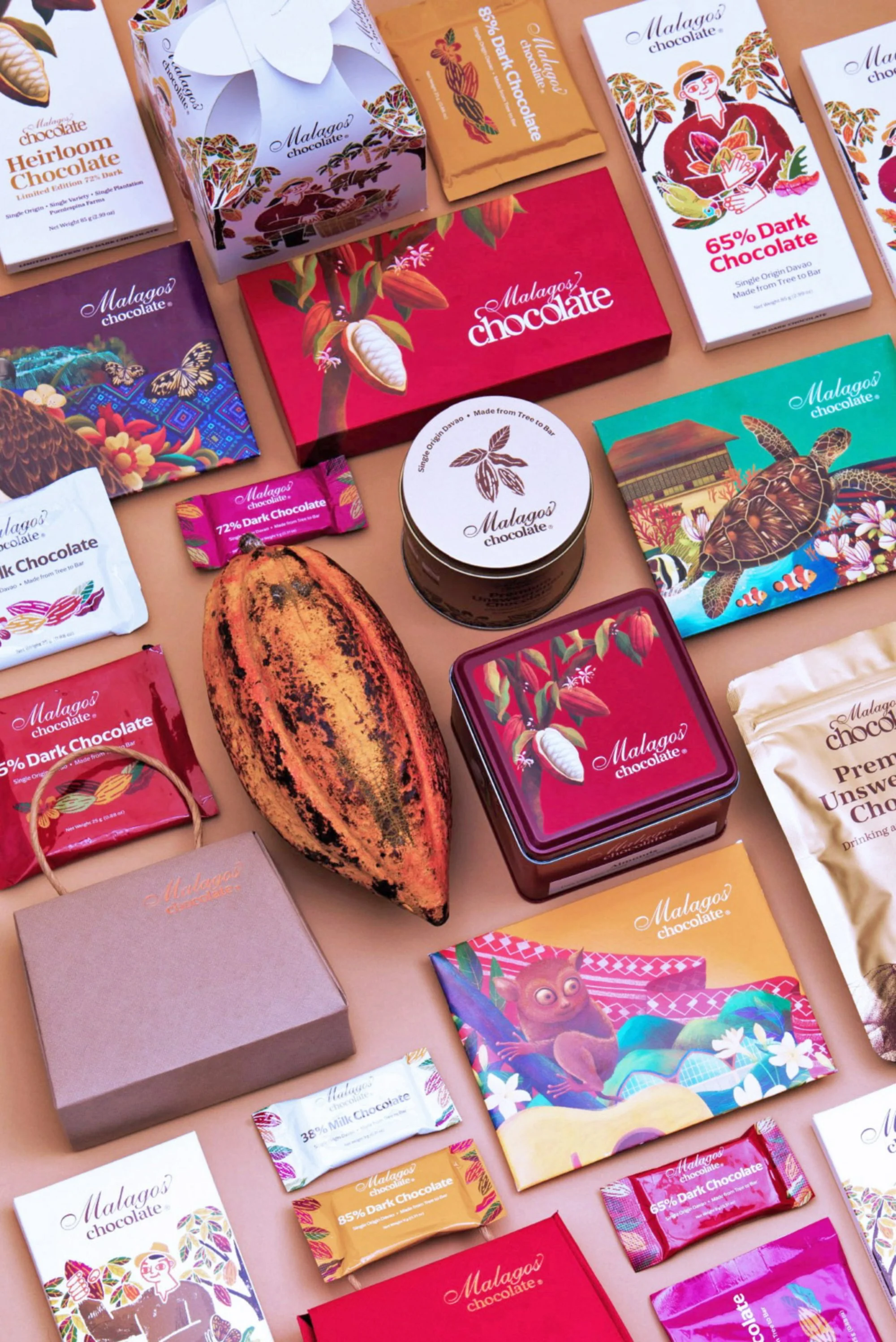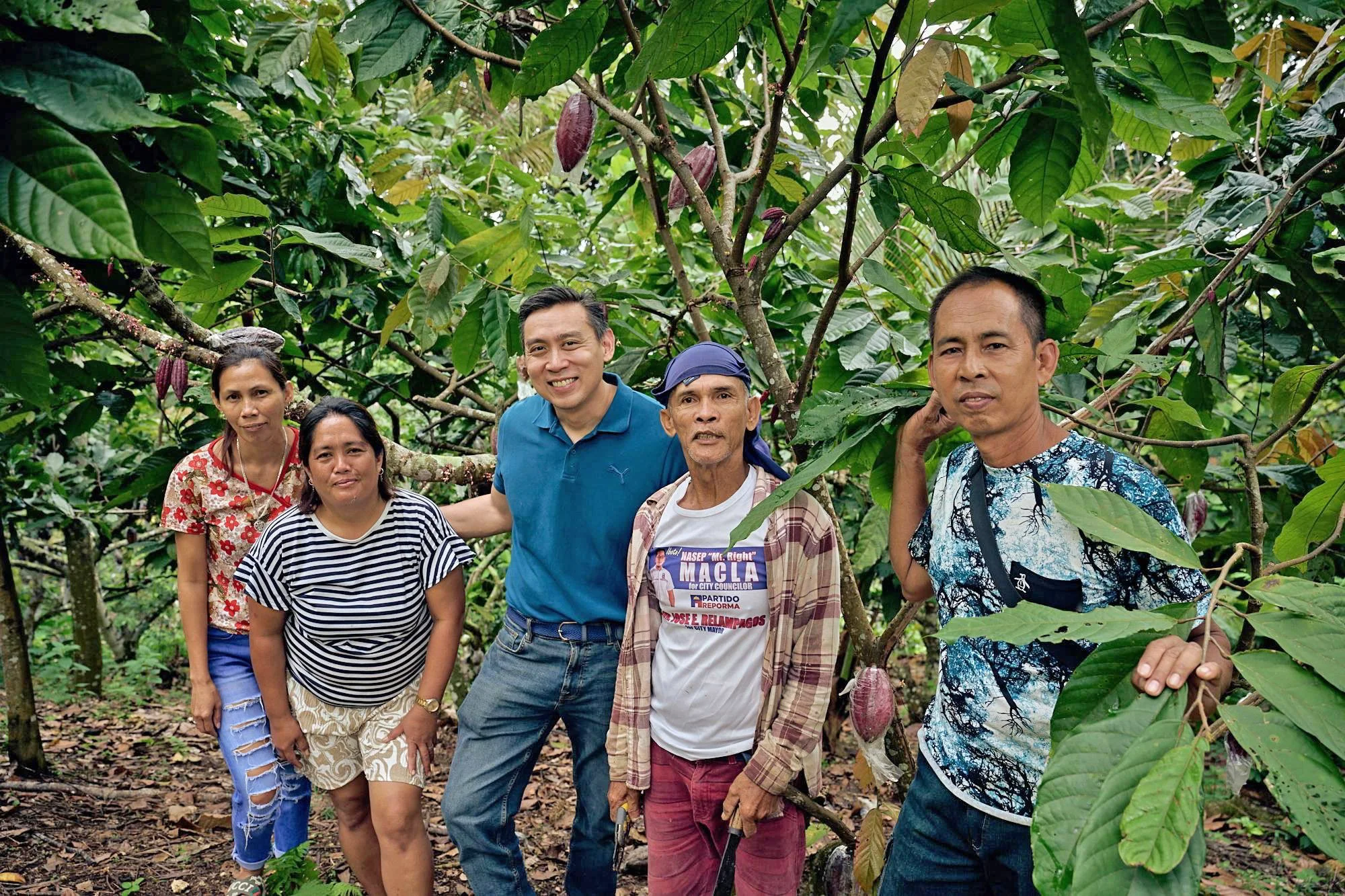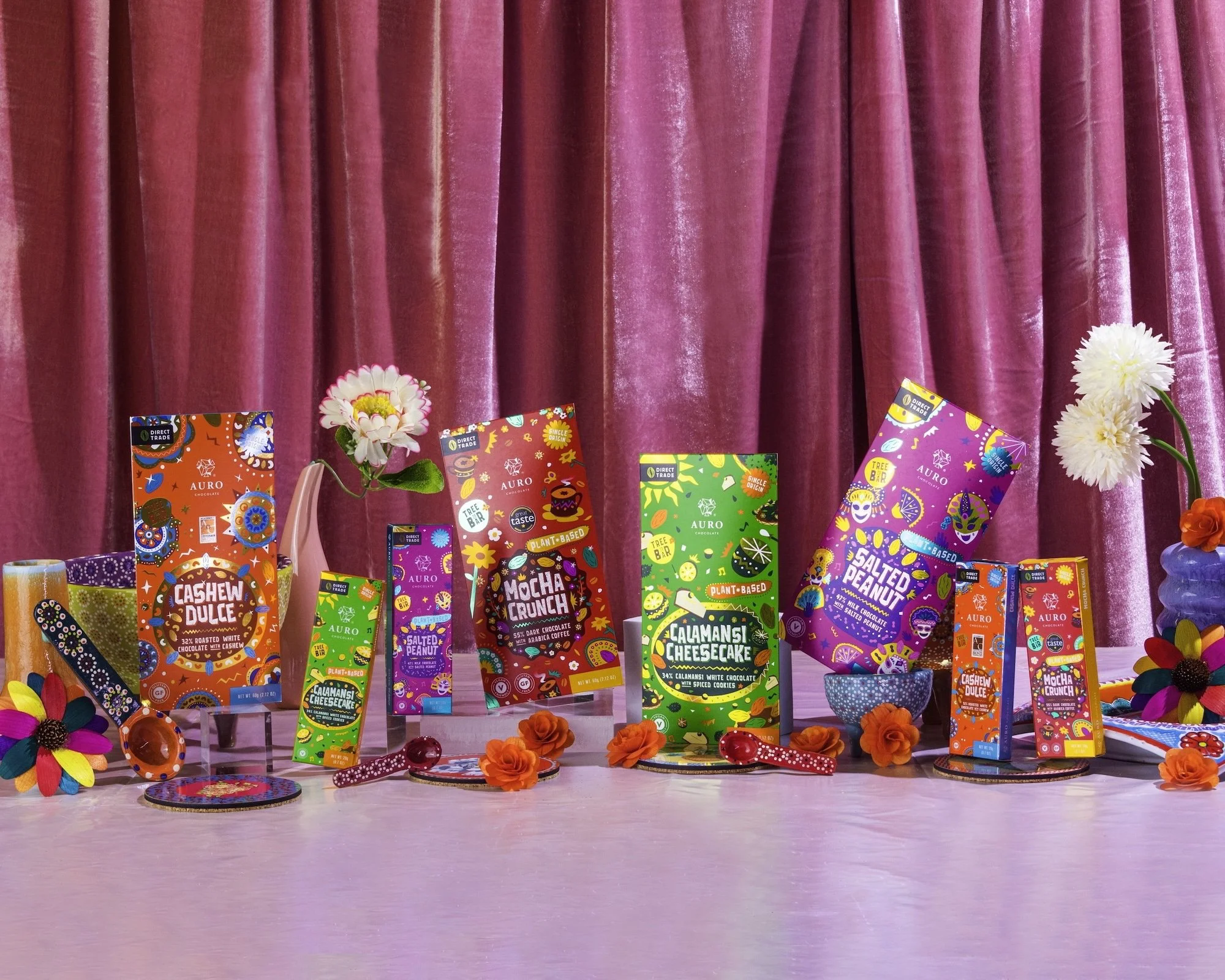What You Should Know About Philippine Chocolate
Cacao pod photo credit depositphotos
Cacao made its way to the Philippines via the Manila Galleon trade between Acapulco, Mexico, and Manila in the late 17th century. It is believed that the rare criollo strain was the first variety planted in Philippine soil. The Spanish established enormous plantations, which was unsurprising, since the Philippines lies within the cacao belt. This is a region spanning from approximately 20° north to 20° south of the equator, with ideal climatic conditions for cacao cultivation.
Modern Cacao Farming
Although introduced long before, modern commercial cacao farming didn’t begin in the Philippines until 1950. However, over subsequent decades, a combination of unfavorable agrarian reform, low market prices, pests, and diseases prompted many farmers to switch to coconut farming. When coconut prices fell in 2010, farmers gradually returned to cacao cultivation.
Today, cacao farming—a remnant of the Philippines’ Spanish colonial past—is experiencing a resurgence. Cacao is cultivated in all regions of the Philippines, but the best climate for growing cacao is in the southern Philippines. Davao, in particular, is home to the majority of cacao farms and rightly earns its title as the cacao and chocolate capital of the country.
At the forefront of this revival are three Filipino chocolate makers: Charita and Rex Puentespina, the mother-son team of Malagos Chocolate; Philo Chua, the owner of Theo & Philo; and Kelly Go and Mark Ocampo, the founders of Auro Chocolate.
Top Chocolate Makers in the Philippines
Malagos Chocolate
Charita Puentespina with Heirloom-Designated Cacao Tree
For Malagos Chocolate, the journey began in 2003 when Charita and her late husband Roberto acquired the farm behind their resort, which was already planted with the Trinitario cacao variety. After rehabilitating the trees, they successfully exported fermented beans four years later. It was then that Charita realized the potential to add value to their raw material by producing fine-quality chocolates themselves, thereby helping local communities by creating jobs—something that would not have been possible if they had only exported the beans. They worked tirelessly to improve bean quality, and in 2012, the pioneering mother-son team of Charita and Rex founded Malagos Chocolate.
Their unwavering determination to create a premium Philippine chocolate brand has led to numerous accolades for their products—56, to date—including awards for their 100% pure unsweetened drinking chocolate, dark chocolate bars (65%, 72%, and 85%), truffles (dark chocolate ganache, rhum, salted caramel, and whiskey), dragée (almonds and roasted cocoa nibs with sea salt), dried soursop covered with dark chocolate couverture, and chocolate beer.
Charita and Rex Puentespina, Puentespina Cacao Farm
The quality of their beans has also garnered acclaim. Notably, Puentespina Farm was recognized as one of the producers of the best 50 beans in the world in 2017 by the Cacao of Excellence Program. Additionally, the Trinitario PF-16 variety grown there was designated as heirloom quality and flavor in 2019 by the Heirloom Cacao Preservation Fund (read more about the Heirloom Cacao Preservation Fund), only the 16th to achieve such recognition worldwide and the first in the Philippines. Rex explains that it’s the environment or terroir—sunshine with even rainfall, elevation, the composition of the soil at the foot of Mount Talomo, biodiversity (including coconuts and other fruit trees growing with the cacao) along with genetics and fermentation, that produces the very fruity and robust cacao flavor of their beans.
Malagos Chocolate Product Range
Malagos Chocolate’s product lineup focuses on unsweetened drinking chocolate, couverture for baking and cooking, and plain dark chocolate bars, which showcase the exceptional quality of their beans and keep the focus on their origin. Additionally, they have expanded their offerings to include innovative byproducts such as cacao juice and cacao vinegar, reflecting their commitment to the sustainable use of cacao.
Their inspiring story reflects their resolute commitment to growing the local cacao industry and to producing a globally competitive, high-quality Philippine chocolate brand, while empowering local communities and farmers. Through their Malagos Cacao Development Center, they support local farmers by purchasing their wet beans directly and sharing expertise on sustainable agricultural and fermentation practices. Since 2017, their interactive chocolate museum—the first and only one in the Philippines—has served as an educational hub, teaching Filipinos and visitors about cacao, chocolate-making, and the tree-to-bar journey.
Theo & Philo
Philo Chua with Gawad Kalinga cacao farming community
When Philo Chua founded Theo & Philo—which means ‘chocolate’ and ‘love’—in 2010, he was the first single-origin bean-to-bar chocolate maker in the Philippines. The idea of producing chocolates from Philippine cacao arose when a gourmet chocolate shop opened in Pittsburgh, where he was living at the time, and he was introduced to single-origin chocolates. His “a-ha” moment came when he discovered that the Philippines lies within the cacao belt.
This was truly a groundbreaking idea because at that time, the locally made chocolates familiar to Filipinos were mainly tableya and compound chocolates. Tableya consists of roasted, ground, and molded nibs of fermented, pure cacao beans used for making sikwate, a traditional hot chocolate drink, and tsamporado, a sweet chocolate-flavored rice porridge. Compound chocolates, on the other hand, use vegetable fat instead of cocoa butter.
Theo & Philo Chocolate Bars Product Range
Theo & Philo produces premium, artisanal chocolate using only locally sourced cacao beans from a single origin. Their beans are sourced from the Gawad Kalinga cacao farming community in Malabog, Davao. By working with the Gawad Kalinga Community Development Foundation and paying higher-than-average market prices for the beans, Theo & Philo helps provide a sustainable livelihood for farmers and farmworkers, thereby contributing to poverty alleviation in the area. "The goal was not just to do well, but if the business does well, then we'll also be able to help people out," Philo says.
Theo & Philo Dark Chocolate with Green Mango & Salt
Award-winning chocolate flavors of green mango and sea salt, labuyo (bird’s eye chili), calamansi (also called calamondin or Philippine lime), pili nut and pinipig (pinipig is flattened and toasted grains of immature glutinous rice), adobo (the Philippines’ national dish), and turon (a sweet banana spring roll) are all rooted in Philippine cuisine. Along with the eye-catching and colorful artwork on the packaging, these flavors showcase Philippine ingredients and make Theo & Philo stand out in both local and global markets. According to Philo, “The inspiration behind our products is the genuine love for anything and everything local—the packaging is designed to display our rich local flora and fauna. The ingredients used are locally sourced, and most importantly, our chocolate flavors are very uniquely Filipino.”
Theo & Philo’s single-origin artisanal line of chocolates has won a total of 22 international awards so far and is being sold at coffee shops and specialty stores locally and around the world—an impressive achievement for a small company.
“Fearless flavors. Fearlessly Filipino” sums up what Theo & Philo chocolates are all about.
Auro Chocolate
Auro Chocolate Fiesta Collection
Auro Chocolate, the fastest-growing premium tree-to-bar chocolate company in the Philippines, was founded in 2015 by Kelly Go and Mark Ocampo. They chose the name Auro (pronounced “oro”), which is a combination of the chemical symbol for gold, Au, and the Spanish word for gold, oro, to represent their pursuit to refine Philippine cacao and elevate the lives of local farmers who are as precious as gold.
From the outset, they envisioned Auro as a social enterprise. Their ethos revolves around social responsibility and sustainability. By working closely with farmers—directly sourcing cacao, paying premium prices, supporting and educating farmers and farming communities—they aim to uplift and transform lives and communities in the Philippines. They acknowledge the impact cacao cultivation has on the environment and are taking steps to mitigate this. They endeavor to further shorten the value chain, and in 2019, partnered with CrowdFarming. Also at the core of their business is transparency and traceability; they publish an annual sourcing report highlighting the percentage of their total expenses that goes to their partner farmers. They also hope that their efforts help promote agriculture as a viable career option for the younger generation.
Auro Chocolate Reserve Collection A
The company was founded in 2015, and by 2017, the brand was officially launched, starting with two chocolate bars. By focusing on innovation and partnerships, they have won over 85 international awards—not only for their chocolates but also for their cacao beans, which they supply to chocolatiers around the world. In 2019, Jose Saguban, their farming partner and member of the Paquibato Tree Developers Cooperative, became the first Filipino cacao farmer to be recognized as one of the top 20 cocoa bean producers by the Cacao of Excellence Program. In 2024, Saloy Organic Farmers Association (SOFA), another farming partner, won the Silver Award at the Cacao of Excellence awards.
Auro Chocolate Fiesta Collection
Their product line includes single-estate dark chocolates and chocolates with bold tropical flavors, exemplified in their Fiesta collection—calamansi cheesecake and ube (purple yam) with coconut and puffed rice—and collaboration with Japanese company Mitsukoshi FRESH—matcha, hojicha (Japanese green tea), roasted miso with shichimi togarashi (seven-spice seasoning), and yuzu. Their products are halal, and they have a growing selection of plant-based white and dark chocolates. They also partner with Filipino brands and have two products with Don Papa rum: 70% dark chocolate with Don Papa rum and 65% dark chocolate with Don Papa rum, calamansi, chili, and honeycomb.
Auro is striving to make Philippine cacao and chocolate known around the world and aims to make it a household name while uplifting and transforming lives and communities in the Philippines. Auro Chocolate is going for gold, and they are well on their way.
Looking forward
The future is bright for Chocolate in the Philippines. Philippine cacao and fine-flavor chocolates are winning international awards and gaining recognition worldwide. Malagos Chocolate, Theo & Philo, and Auro Chocolate are truly vanguards—charging ahead and proudly waving the Philippine flag.










